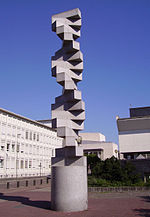Friedrich-Engelhorn-Hochhaus
Buildings and structures demolished in 2014Buildings and structures in LudwigshafenFormer skyscrapersOffice buildings completed in 1957Skyscraper office buildings in Germany

The Friedrich-Engelhorn-Hochhaus was a 28-storey, 101.63 m (333.4 ft) skyscraper in Ludwigshafen am Rhein, Germany. When completed in 1957 as the headquarters for BASF, it was the tallest building in Germany. Demolition of the building began in late 2013 and was completed in February 2014; new headquarters for BASF will be built on the site.
Excerpt from the Wikipedia article Friedrich-Engelhorn-Hochhaus (License: CC BY-SA 3.0, Authors, Images).Friedrich-Engelhorn-Hochhaus
Carl-Bosch-Straße, Ludwigshafen am Rhein
Geographical coordinates (GPS) Address Nearby Places Show on map
Geographical coordinates (GPS)
| Latitude | Longitude |
|---|---|
| N 49.495972 ° | E 8.432167 ° |
Address
Carl-Bosch-Straße
Carl-Bosch-Straße
67063 Ludwigshafen am Rhein
Rhineland-Palatinate, Germany
Open on Google Maps










